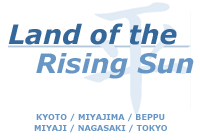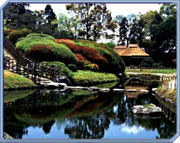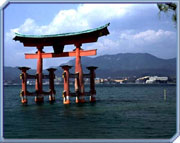 |
 |
 |



Land of the Rising Sun: Day-by-Day Itinerary
Please read this page for a detailed day-by-day itinerary for the tour or click HERE for a print friendly version.
Day 1: Kyoto
Depending on your arrival time you will be met at Osaka’s futuristic Kansai airport and escorted to the hotel in Kyoto. Tonight is the first chance to experience some of Kyoto’s legendary cuisine.
Day 2: Kyoto
Flanked on all sides by lush, forested hills, and with the shallow waters of the cherry tree-lined Kamagawa river flowing gently down its length, Kyoto lies in a delightful setting. Originally modelled on Xian in China the city’s long and rich history reaches back to a time well before it’s choice as imperial capital in the eighth century. Since then generations of artisans and benefactors have helped build a legacy of almost 2000 Buddhist temples, Shinto shrines and Zen gardens. The ensuing centuries have seen the city become a paradise not just for the pilgrim but also for the pleasure seeker and in the cobbled streets of the Gion quarter it is still possible to steal a glimpse into the enigmatic and often misunderstood world of the Geisha. With such a limitless wealth of treasures and traditions the city today stands proudly at the country’s cultural heart, still managing to effortlessly encapsulate all that is magical and refined about Japan. Kyoto remains, for many a visitor, the finest city in Asia.
This morning an orientation tour takes us to some of Kyoto’s more important sites: the architecturally impressive Higashi - Honganji temple; the imposing and opulent Nijo Castle, formerly home of the Tokugawa shoguns, and finally, nestling at the foot of Kyoto’s north western hills, the extravagantly decorated Kinkakuji temple, immortalised in Yukio Mishima’s novel ‘The Golden Pavilion’. From here it is possible to walk the short distance to Ryoan-ji, perhaps Japan’s most famous Zen garden. The rest of the afternoon is free. In the early evening there will be an introductory briefing followed by dinner at one of the city’s more unusual restaurants situated near the new, and architecturally astounding, railway station. Later, for the energetic, there will be a night tour, carefully researched, of Kyoto’s entertainment district with its street musicians, canal side bars and youthful neon verve!
Day 3: Kyoto
Free day. Kyoto is a city that lends itself to walking and there are many differing routes that can be taken. Recommended is a gentle stroll through the eastern hills along the ‘Path of Philosophy’ that links Ginkakuji, the Temple of the Silver Pavilion with Nanzenji Temple. This walk can be extended south via Heian shrine and on through well-preserved old town areas to Kiyamizu-dera, the Temple of Clear Water. From here there is a justifiably famous view across a wooded gorge toward Kyoto. Also recommended for those visiting in spring is a visit to the Kaburenjo theatre for a presentation of Miyako Odori, the Cherry Blossom Dance, performed by elaborately dressed Maiko, apprentice Geisha. In the late afternoon for those who wish there will be a short walking tour of Gion, the Geisha district, including the possibility of taking tea in one of the old teahouses mentioned in the recently acclaimed novel Memoirs of a Geisha. Later a traditional dinner will be served in one of the many restaurants of the Pontocho area.
Day 4: Kyoto - Day trip to Nara
This morning we make a short journey by train to Nara, formerly Heijo, Japan’s first true capital. The composition of today depends very much on the weather and the whims of the group but at its least will include a visit to the awe inspiring Todaiji temple, the largest wooden structure in the world and home to Japan’s largest bronze statue of the Buddha. There will also be a visit to the important Kasuga-jinja Shinto shrine, with its vermilion pillared corridors, and the Kofukuji temple. The afternoon is free to continue exploring Nara and perhaps visit the intriguing and culturally important Horyu-ji temple. Alternatively it’s possible to return early in the afternoon to spend more time in Kyoto.
Up to summary
Day 5: Miyajima (via Okayama)
Today we travel by Bullet Train to Hiroshima. En route we can pause in Okayama and the option of visiting the celebrated Korakuen Garden, one of Japan’s ‘Big Three’ classical gardens. Constructed at the end of the 18th Century Korakuen, meaning ‘Garden for Taking Pleasure Later’, is situated on a sandbank of the Asahi River and is overlooked by the commanding heights of Okayama Castle. Like Ginkakuji in Kyoto, it is classified as a ‘stroll garden’, or shuyu, with a winding path that allows the garden to slowly unfurl and reveal itself in all its many aspects.
On arrival in Hiroshima we will visit the A-Bomb Museum and Peace Memorial Park which both stand testimony to the fateful day in August 1945 when the city was chosen as target for the first ever wartime use of the atomic bomb. We then head for the enchanting island of Miyajima, which we reach after a short ferry journey across the inland sea. The island is home to the venerable shrine of Itsukushima, famous for its huge vermilion gate, or torii, which rises majestically out of the sea. At high tide it is considered to be one of the most beautiful sights in Japan. Miyajima is another place that lends itself to walking and, as we will be spending the night here, there is plenty of time for exploration. In the evening, after most visitors have returned to the mainland, Miyajima takes on a magic all of its own.
Up to Summary
Day 6: Beppu
This morning is free to explore Miyajima Island. There is the lovely Momaji Park, known as Maple Valley, from where it is possible to either walk, or take a cable car, up to the top of Mt. Misen. The summit is home to a colony of wild monkeys and there are also fine, sweeping views over western Honshu and the island studded Inland Sea. Also of note is Daishi-in Temple. In the afternoon we leave Honshu and cross over to the island of Kyushu making our first stop in the spa town of Beppu. Gloriously situated, with the coast on one side and mountains behind, Beppu is indeed an unusual and extraordinary place. Throughout the town pillars of steam rise up like smoke signals, as a reminder that this is one of the worlds most geothermally active regions. Beppu is one of Japan’s more popular resorts and it’s attractions, ranging from the refined to the fascinatingly tacky, are many! It is likely that we will stay at the Suginoi Hotel, famous throughout Japan, and a travel experience in its own right. Approached with the right attitude, Beppu can be a lot of fun!
Day 7: Beppu
Free day. There is something for everyone in Beppu though many of the town’s attractions revolve around its health giving waters. In the Kannawa area are found Beppu’s famous jigoku or ‘hells’, a collection of hot, multi coloured lakes, geysers and bubbling pools of mud surrounded by unusual and beautiful botanical gardens. Nearby, but not necessarily recommended, are the mixed, nude Myoban mud baths that claim to cure ills as diverse as arthritis and insanity! Also in the Kannawa area is the bizarre, and highly amusing, Ashiya Sex Museum. For a far more relaxed and less touristy experience, however, a visit to the Takegawara Onsen is recommended. Here in this delightful old Meiji era wooden building, the aches and pains of the day are eased away by the hot black sand that is piled on by muscle-bound, laughing old ladies. For an open-air version there are also hot sand baths available down on the beach and the possibility of swimming too.
Up to summary
Day 8: Miyaji - meals: dinner
Leaving behind the wonders of Beppu we climb by local train into the mountains of Kyushu’s rural hinterland where we find a slower more traditional way of life. The main attraction of this area is the Aso Caldera, a huge and ancient volcanic crater home to numerous farming villages and fertile agricultural land. Within this crater are five smaller cones known together as Mt. Aso. The scenery here can be dramatic and travelling up to the base of Nakedake the lush meadows grazed by horse and cattle slowly give way to a starker, more volcanic landscape from where there are stunning views of the surrounding countryside. It is possible either by foot or ropeway to ascend the short distance to the top of Nakedake peak and peer down through sulphurous clouds to the eerie and seething grey green lake that lies at its heart. From here it is possible to return by bus or alternatively take an interesting hike through beautiful scenery back to our minshuku in Miyaji.
Up to summary
Day 9: Nagasaki (via Kumamoto) - meals: breakfast
The trip down from Mt. Aso to Kumamoto ranks as one of Japan’s great railway journeys as the small train passes through and regularly stops at rural hamlets to pick up farmers and their produce before descending from the volcanic heights by a series of switchbacks. We break our journey in Kumamoto where we have the option of visiting one of Japan’s most highly regarded ‘stroll’ gardens, Suizenji. Carrying on through Kyushu’s attractive countryside we eventually reach the charming and picturesque harbour of Nagasaki.
Day 10: Nagasaki
Free day. Japan’s first contacts with the West took place in Nagasaki with the arrival of missionaries and traders from Portugal and the Netherlands. Foreigners were at first confined to the small enclave of Dejima but soon as their influence spread, and trade grew, so did their concessions. One of the most interesting parts of Nagasaki is the hillside Glover Garden named after the influential Scottish entrepreneur Thomas Glover. Here, set amidst the gardens, many fine turn of the century European residences look out over the harbour. An ill- timed break in the clouds lead to Nagasaki having the misfortune of becoming the worlds second target for an atomic bomb that had originally been intended for the cloud bound Fukuoka. This part of the city’s history is commemorated in the Peace Museum and Peace Park situated in the north of the city. Also recommended is an evening cable car trip to the top of Inasa-yama for a spectacular night-time panorama of the city. With its easy to use tram system, many of whose streetcars are museum pieces in themselves, Nagasaki is a joy to explore. Blessed with a cosmopolitan and relaxed atmosphere the city is remembered by many visitors as one of the most pleasant experiences in all Japan.
Up to summary
Day 11: Tokyo
Today we travel back East to Tokyo breaking our journey briefly in Kyushu’s provincial capital of Fukuoka. As we speed our way by ‘Bullet train’ we may in fine weather be afforded beautiful views of Japan’s most sacred symbol, the snow-capped Mount Fuji. Arriving at Tokyo station in the late afternoon we transfer the short distance to our hotel.
Day 12: Tokyo
Tokyo is well known for its bustling energy and futuristic architecture. It also has a gentler side and its citizens often reveal themselves, particularly outside of working hours, to be some of the friendliest of any capital city in the world. There are many vestiges of the past too with historic temples and shrines still to be found in some of the most unexpected places as well as an abundance of parks and gardens which are particularly exquisite in spring when the cherry trees and azaleas are in bloom. Today we have a full day tour of the city taking in among other things a view of the Imperial Palace with its East Garden, the lively Senso-ji temple in the district of Asakusa, a trip to Shinjuku for panoramic views of the city and a short tour of Kabuki-cho, the Soho (but more so!) of Tokyo.
Day 13: Tokyo - meals: dinner
Free day. Today is a free day for further individual exploration or shopping. Day trips outside of Tokyo are also possible, either to the Hakone area of Mt. Fuji, or, recommended, to the magnificent Tokugawa shrines of Nikko, home of, amongst many other things, the famed three monkeys for whom evil is neither seen, nor spoken, nor heard! In the evening a visit to Tokyo’s unforgettable nightlife district of Roppongi can also be recommended.
In the evening we will be tucking into a farewell dinner together as sadly tonight marks the last night of the tour and tomorrow we will all be heading our separate ways.
Up to summary
Day 14: Depart
It is that sad time when we all have to say our goodbyes and head our separate ways. Your ticket back to the airport is included and your Buddy will help you make the transfer and ensure that you are in good time for checking in. We wish you all the best for a safe journey home and hope that perhaps one day you will return to Japan for some more adventures in the Land of the Rising Sun.
Up to summary
Other Information
Gardens: As well as the smaller gardens in Kyoto this tour also visits the classic gardens of Koraku-en in Okayama and Suizen-ji in Kumamoto. Also recommended on free days are optional visits to Glover Garden in Nagasaki and Koishikawa Korakuen in Tokyo.
Walking: Although by no means compulsory, there are, for those who wish, plenty of opportunities for short walks in addition to the published itinerary. These will generally be escorted by the tour leader although most can be taken unguided. Of particular interest are hikes around Daimon-ji Yama in Kyoto, Yufu Dake in Beppu and the ascent of Mt. Misen on Miyajima island. Details of these walks, none of which are particularly strenuous, can be found in Lonely Planet’s excellent ‘Hiking in Japan’.
Transport: Please note that all transfers are by public transport making use of Japan's first-rate transport network. You will have to carry your bags for short distances and some stations do not have escalators. We highly recommend that to make your stay more enjoyable you pack reasonably light. Large suitcases will be an inconvenience to you. A small case or bag or best of all, a rucksack, are most appropriate for this tour.
Accommodation: In Kyoto and Beppu the hotels are comfortable four star standard. In Nagasaki and Tokyo we stay in a comfortable three star hotels, centrally located. In Miyaji we stay in a traditional, family run minshuku and on Miyajima island we stay in a characterful Japanese style guesthouse. Twin share basis. Single supplement may be applicable as a single traveller you are not happy to share with someone of the same sex.
BACK TO TOP
|
|



